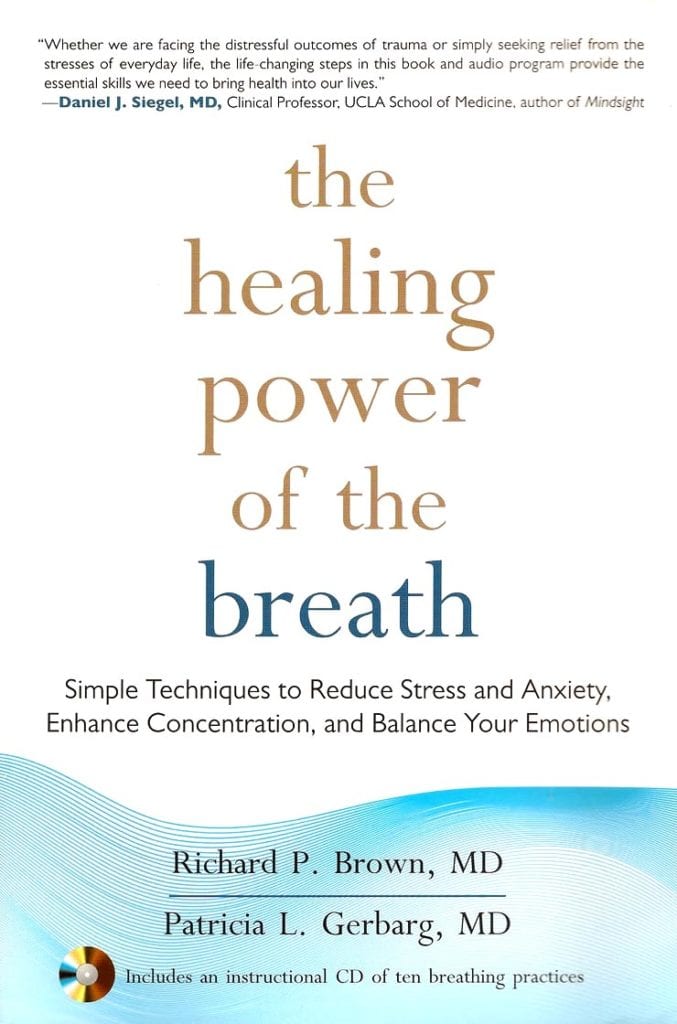Many patients in my Washington DC acupuncture practice have two goals in common—to experience fundamental emotional peace and greater physical well-being. And they want to find ways to sustain this peace and well-being in their daily lives.
They may not call it a desire for peace and well-being, but instead may voice a desire to reduce their stress, anxiety and panic attacks. To focus, clear their mind, and help with ADD. To lift their energy and depression, experience less muscle tension and pain, and reduce symptoms of insomnia.
There are many ways to address all these issues. One primary way is conscious breathing. I often teach my patients abdominal breathing exercises, but there is a greater range of breathing exercises available.
I have been looking for a book that described a basic yet comprehensive approach to learning and practicing breathing exercises, and I’m happy to say I’ve found a good one. It’s called The Healing Power of the Breath, by psychiatrists Richard Brown and Patricia Gerbarg. You can see part 1 of my book review below, but first I’ll give you a short review of how breathing has helped me in my own life.
Breathing for Emotional Release
Breathing consciously is a major method for healing the body, emotions and mind. Part of my own healing over the last 3 years has been facilitated by Transformational Breathwork, as taught by my mentor Ken Yamaguchi-Clarke. This was a 3-year Transformational Healing and Bodywork mentorship I finished this past year.
This type of breathing helps one to remain conscious and present as hidden emotional and physical tension is released from the depths of the body into consciousness. The breath helps one stay present and aware during this process, instead of over-reacting, “checking out” or distracting oneself. This presence is a key to liberating oneself from the grip of deeper-level emotional and physical tensions.
Another valuable style of breathing—abdominal breathing—comes from my education in tai chi and qigong. This style of breathing helps one release tension in the diaphragm, thus allowing the breath to fully fill the lungs and relax habitual tension in the abdomen. This style of breathing is great for maintaining calm and centeredness during daily life.
Ujjayi pranayama is a breathing exercise that I practice during my Mysore-style Ashtanga yoga practice, for about 1 hour in the morning. The details of this style of breathing are well described in “The Healing Power of the Breath.”
The effects that I notice are: I almost always walk out of a yoga session more centered, open-hearted, clear-headed, and bright. Part of this is the asana, or yoga postures; part of it is the savasana, or restful meditation at the end; and part of it is the ujjayi breathing (also known as “Darth Vader breathing”) practice that takes place during the entire yoga practice.
Breathing for Centering
I’ve also benefited from the practice of breathing combined with visualization. In Taoist meditation taught to me over the course of several years (beginning with my teacher Sifu Hing Cheung of Victoria, British Columbia), breathing is combined with visualizing energy moving along the meridian pathways of the body. This helps “open” the energy flow in these areas. Opening these “energy passageways” can lead to remarkable feelings of the body being suffused with energy and “glow.”
In the Kashmiri style of yoga taught by my spiritual teacher Rupert Spira, breath is combined with visualization of the oneness of the body with the environment, leading to perceptions of “global” awareness that pervades the entirety of one’s field of perception.
This is useful in helping one become aware on a “felt level” of the primary experience that the non-dual spiritual path points to—that “you” actually “is” the entirety of your perceived experience, including your body, emotions, and thoughts, other people and “the environment around you.”
Three Fundamental Styles
As you’ll see from the book review here, the authors have nicely organized 3 fundamental styles of breathing consciously into what they call the “total breath.” These are:
- Coherent breathing
- Ujjayi breathing
- Breathing with visualization
They have a CD to accompany the book, which acts as a good guide for learning and practicing the exercises. When practiced for 20 minutes daily, this can be a powerful and very effective means for transforming your health and emotions.
As a patient, new or returning, you will have the chance to learn and practice these breathing techniques in our sessions. Just let me know at the beginning of the session that you’d like to focus on learning the essential breathing techniques.
Book Review

The Healing Power of the Breath: Simple Techniques to Reduce Stress and Anxiety, Enhance Concentration, and Balance Your Emotions
The Healing Power of the Breath, by Richard Brown, MD and Patricia Gerbarg, MD
From the Introduction:
“Throughout history, great healers have discovered the power of breathing to enhance the physical, mental, and spiritual well-being of their people. Once secret and sacred, breath practices are now available to everyone… [O]ur book offers … simple, natural methods to become calmer, overcome stress, boost energy, focus your mind, enhance physical fitness, sleep peacefully, and feel closer to those you love. We will teach you core breathing techniques, explain how they work, and show you how to use them to meet the many challenges you face.
The human body has the power to heal itself from the cellular level up. We regenerate our body tissues every day. Before the advent of synthetic medications, shamans, monks, priests, and tribal leaders learned how to turn on the body’s natural abilities to prevent and cure illness. Breathing practice (pranayama) is one of the classical limbs of yoga and can be found in modern yoga studios around the world.
While yoga practitioners and martial artists employ breathing techniques, the modern science of breath is exploring the vast healing potential of the human respiratory system. Studies are revealing that by changing the patterns of breathing it is possible to restore balance to stress response systems, calm an agitated mind, relieve symptoms of anxiety and post-traumatic stress disorder (PTSD), improve physical health and endurance, elevate performance, and enhance relationships.
The stresses of modern life induce negative emotions such as anxiety, frustration, anger, and cynicism. In addition, stress accelerates the decline in physical health due to cardiovascular disease, obesity, inflammation, and immune dysfunction. The daily use of breathing practices can turn back the tide of stress, counteract disease progression, and improve overall quality of life.
Along with its physical toll, stress is also wearing on the spirit: it can lead to the buildup of emotional defenses that choke off our capacity for love, compassion and intimacy. Breath practices combined with self-reflection can unlock the metal casing around the heart, enabling reconnection with loving feelings and positive emotions within ourselves and in our relationships.”
Technique 1) Coherent Breathing
For each person, there is an optimal rate of breathing, somewhere between 3.5 and 6 breaths per minute. At this rate of breathing, stress reduction and cardiovascular function are optimized. This is called the “resonant rate” by modern researchers, but has also been described by spiritual practitioners in many cultures.
Brown and Gerbarg recommend 5 or 6 breaths per minute for their Coherent Breathing exercise for most adults.
The exercise begins with belly breathing and relaxation. It then continues with breathing at 5 or 6 breaths/minute for up to 20 minutes. The CD included with a book has tracks with chimes to help you time your breathing appropriately. Helpfully, the book covers several challenges people encounter with this practice, and how to overcome them.
Technique 2) Body Scan
Use this at the end of the Coherent Breathing practice, as a transition to normal life activities. This consists simply of directing attention to each area of the body, one by one, from top to bottom. The authors have a recorded version of the body scan on the CD.
They also give instructions for a Pulse Awareness Body Scan, where you learn to feel the pulse in each area of the body. This seems like a very interesting practice, but I haven’t tried it yet myself.
Technique 3) Resistance Breathing
Creating resistance to the out-breath is similar to a cat purring. This vibrational sound actually relaxes the nervous system—when a cat is purring it is not only an expression of relaxation, but it is actually creating the relaxation itself. Singing is another common example of resistance breathing.
The authors focus on another method of resistance breathing called Ocean Breath (or ujjayi breathing in yoga). This is one of my favorites because I practice it with my Ashtanga yoga practice. After learning ujjayi breathing, you add it to the Coherent Breathing practice, practicing it during the exercise of breathing 5-6 breaths per minute.
Technique 4) Breath Moving
Breath Moving is the authors’ term for visualizing the breath moving through different parts of the body while breathing in and out. This is a common technique used in yoga, tai chi, qigong, and other disciplines, and is designed to clear out “blockages” in the flow in internal energy. Chinese medicine, as well as other traditional forms of medicine, consider energy blockages to be the root cause of illness.
The two visualizations they suggest are in the form of 2 circuits of energy. Circuit #1 is up the spine, and down the front midline of the body. Circuit #2 is from the head out through the feet, and back up again. These 2 circuits thoroughly flush the body, and strongly move qi, or vital energy. These circuits were also used in the Taoist meditation and qigong classes that I took for several years.
Circuit #1 is called the Microcosmic Orbit, and #2 is the Macrocosmic Orbit. They are foundational methods for opening up the body to accept a greater flow of internal and cosmic energy (internal energy is energy that is already in the body; cosmic energy is energy from the external environment).
The authors suggest adding this technique in with the Coherent Breathing and Resistance Breathing.
Technique 5) Total Breathing
Simply combine Coherent Breathing, Resistance Breathing and Breath Moving for 20 minutes.
An Ideal Complete Practice
- Physical Movement/Stretching/Warmup/Workout
- 20 minutes of Total Breathing
- Relaxation/Body Scan/Meditation
This concludes Part 1 of the book review. Stay tuned for Part 2, which describes focused breathing techniques to solve particular health issues.







